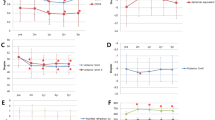Abstract
We retrospectively evaluated 41 corneal wedge resections, performed for the correction of high astigmatism in 40 patients who were spectacle and contact lens intolerant. Keratometric astigmatism decreased from an average of 11.7 diopters (range 5 to 22.5 D) preoperatively to 3.5 diopters (range 0 to 10 D) postoperatively, representing a mean reduction of 8.2D (range 0 to 16.5), or 70%. The length of follow-up averaged 11 months. Twenty-five, 15 and 9 cases had a follow-up of at least 3, 5 and 10 years, respectively. In 16 cases the keratometry readings remained stable over the years. However, in 1 case of Fuchs' endothelial dystrophy (follow-up 13 years) and 5 cases of keratoconus (follow-up 3, 4, 12, 13 and 14 years) the astigmatism gradually increased during the various follow-up periods. In 3 other cases the astigmatism gradually decreased over the years. Corneal wedge resection is an effective technique for managing high corneal astigmatism. The results remain stable over the years except in some patients with keratoconus.
Similar content being viewed by others
References
Troutman RC. Microsurgery of the Anterior Segment of the Eye, Vol 2. St Louis: Mosby 1977; 263–286.
Troutman RC, Swinger C. Relaxing incision for control of postoperative astigmatism following keratoplasty. Ophthalmic Surg 1980; 11: 117–120.
Lindstrom RL, Lavery GW. Correction of post-keratoplasty astigmatism. In: Sanders DR, Hofmann RF, Salz JJ (eds): Refractive Corneal Surgery. Thorofare, New Jersey, SLACK 1986; 215–240.
Lavery GW, Lindstrom RL, Hofer LA, Doughman DJ. The surgical management of corneal astigmatism after penetrating keratoplasty. Ophthalmic Surg 1985; 16: 165–169.
Sugar J, Kirk AK. Relaxing keratotomy for post-keratoplasty high astigmatism. Ophthalmic Surg 1983; 14: 156–158.
Lindstrom RL, Lindquist TD. Surgical correction of postoperative astigmatism. Cornea 1988; 7: 138–148.
Troutman RC. Corneal wedge resections and relaxing incisions for postkertoplasty astigmatism. Int Ophthalmol Clin 1983; 23: 161–168.
Krachmer JH, Fenzl RE. Surgical correction of high postkeratoplasty astigmatism. Relaxing incisions vs wedge resection. Arch Ophthalmol 1980; 98: 1400–1402.
Troutman RC. Microsurgical control of corneal astigmatism in cataract and keratoplasty. Trans Am Acad Ophthalmol Otolaryngol 1973; 77: 563–572.
Van Rij G, Vijfvinkel G. Correction of postkeratoplasty astigmatism by Razor blade and V-shaped knife wedge resection. Ophthalm Surg 1983; 14: 406–410.
Lugo M, Donnenfeld ED, Arentsen JJ. Corneal wedge resection for high astigmatism following penetrating keratoplasty. Ophthalmic Surg 1987; 18: 650–653.
Dutescu, M, Reim M, Schmidt-Martens FW. Operative Korrektur des starken Astigmatismus nach Keratoplastik. Klin Monatsbl Augenheilkd 1983; 182: 191–195.
Mandel MR, Shapiro MB, Krachmer JH. Relaxing incisions with augmentation sutures for the correction of postkeratoplasty astigmatism. Am J Ophthalmol 1987; 103: 441–447.
McCartney DL, Whitney CE, Stark WJ, Wong SK, Bernitsky DA. Refractive keratoplasty for disabling astigmatism after penetrating keratoplasty. Arch Ophthalmol 1987; 105: 954–957.
Limberg MB, Dingeldein SA, Green MT, Klyce SD, Insler MS, Kaufman HE. Corneal compression sutures for the reduction of astigmatism after penetrating keratoplasty. Am J Ophthalmol 1989; 108: 36–42.
Vijvinkel G, Van Loenen Martinet AHJ. Contact keratoscope for clinical and surgical use. Int Ophthalmol 1981; 4: 177–178.
Van Rij G, Waring III GO. Changes in corneal curvature induced by sutures and incisions. Am J Ophthalmol 1984; 98: 773–783.
Binder PS. The effect of suture removal on postkeratoplasty astigmatism. Am J Ophthalmol 1988; 105: 637–645.
Musch DC, Meyer RF, Sugar A, Soong HK. Corneal astigmatism after penetrating keratoplasty: the role of suture technique. Ophthalmology 1989; 96: 698–703.
Binder PS. Selective suture removal can reduce postkeratoplasty astigmatism. Ophthalmology 1985; 92: 1412–1416.
Pallikaris I. Die präoperative Placidophotographie bei Keratokonus und ihre Bedeutung im Zusammenhang mit dem postoperativen Astigmatismus. Graefes Arch Klin Exp Ophthalmol 1980; 213: 87–99.
Troutman RC. Astigmatic considerations in corneal graft. Ophthalmic Surg 1979; 10: 21–26.
Author information
Authors and Affiliations
Rights and permissions
About this article
Cite this article
Hoppenreijs, V.P.T., Van Rij, G., Beekhuis, W.H. et al. Long-term results of corneal wedge resections for the correction of high astigmatism. Doc Ophthalmol 75, 263–273 (1990). https://doi.org/10.1007/BF00164840
Accepted:
Issue Date:
DOI: https://doi.org/10.1007/BF00164840




